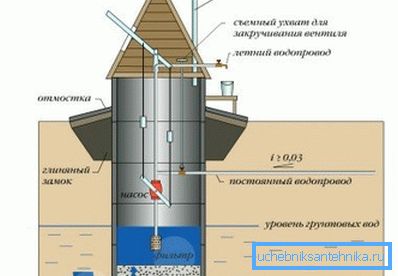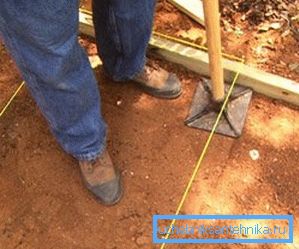How to make a clay castle for the well
The clay castle is used around the perimeter of the well in order to protect the source of drinking water from the entry of water into it, as well as other dirty water through the walls of the well shaft.
If the depth of the structure is sufficient, it is not necessary to install it, but for shallow structures it plays an essential role, without which it can not be done.

General information
The device of the clay castle well process is quite time-consuming and it is necessary to prepare a significant amount of material for it. At the end of the work, it is necessary to clean the well of possible contamination so as not to worry about the quality of the water..
Instructions for creating a clay castle usually consists of 3 stages, although it is possible to make adjustments to it:
- Along the perimeter of the well shaft they make a trench with the following dimensions: width - 500-600 mm, depth 1500-1500 mm.
- Clay is poured into it, which must be periodically tamped.
- A small blind area is made over the castle with a slope away from the well, its height is 150-200 mm.
Below we consider how to make a clay castle around the well in more detail.

Technology
- For a clay castle, you must take the material of natural moisture. When it comes out of the ground for later storage, it should be soaked with water and covered from above.

You can check the condition of the clay by trying something out of it, the material should not crumble and slip between your fingers. It may be necessary to add 10-20% lime to it in order to neutralize the increased content of sand in it.
Tip: wrinkle a piece of clay and see if it holds the shape, does not spread between the fingers and does not crumble to pieces, to see if the material is ready for use.

- The best result will be with careful tamping of clay in the formwork. To do this, take wooden boards and set so that the thickness of the lock was 150-200 mm. When the pit is not wide and the material is sufficient, the walls are usually the formwork. To ram the clay is necessary in layers with a height of 200-300 mm.
- Place a geotextile web outside the castle that will prevent erosion of the structure by groundwater.
Tip: when the pit is not wide, you can not put the formwork.
- A clay castle is made like a blind area for a house. Its width is from 1 m, it may not necessarily be deep, from 0.5 m. Although it is better that the dimensions are larger. If a water pipe goes from a well source to a private house, it should also be isolated with a lock, regardless of the depth of its installation. You can cover the clay on top with geotextile, putting a cobblestone or paving slab on top of it.
Tip: protect the clay blind from above with a geotextile or pave it.
From the above, it became clear that clay is a traditional material and promising in terms of waterproofing various structures, in particular, the well shaft from ground moisture. Its price is cheap, since it can literally be found underfoot, and working with it does not require special qualifications, skills and a complex tool, although it is laborious.
Is it possible to replace clay
On the market today you can find enough companies offering to replace clay with a mixture of sand with gravel or just sand. It should be understood that they simplify the work themselves, but not to the consumer.

If you logically look at the problem, then you can understand whether such a lock is needed or not. The fact is that sand is not intended to retain water, but only passes it through itself, working on the principle of a filter. After it, the fluid reaches the walls of the concrete rings and rushes through the possible cracks into the shaft of the well. (See also the article Filtering well: features.)
Advice: it is better to make a clay castle along the perimeter of the source - the well will only benefit from this.
Clay is a material that is impermeable to water, although it can get wet superficially. Because of this, in the winter with severe frosts, it is sometimes possible to observe a slight movement of the rings of the well.
The material does not allow penetration of surface water and wet the soil, therefore, despite the variety of mixtures for locks, they are not able to replace the clay.
Protection of well rings against displacement
To prevent the well shaft from shifting from concrete rings, fabricate an additional mount using stainless steel plates with anchor bolts. Plastic nonwovens, which do not rot, have also proven themselves well.
Their laying should start from the ground, and finish 200 mm below the second seam. Thus, you will receive additional protection from the penetration of the water pipe, and do not allow spillage of clay due to non-tightness of the seams.
Tip: To reduce the coefficient of adhesion of clay and rings, use non-woven plastic materials that do not rot.
How to ram the clay
Work should be carried out for several visits, after laying 150-200 mm of clay. Sometimes, because of poor-quality compaction, it was often necessary to redo everything anew. The finished clay for the castle should have a moisture content of 15-30%, which should not be forgotten.
Tip: use to achieve a better tamping effect with a small area of the sole, but of considerable weight.
Now you need to remember when to make a clay castle. It is not installed immediately after the manufacture of the well, you need to allow the soil around the perimeter to settle and settle.

Otherwise, cracks in the ground will make the lock useless. You can do the work yourself or with an assistant, or you can seek help from professionals.
Conclusion
The clay lock on the well protects the source of drinking water from falling into it, thereby preserving the quality of the liquid. It is not necessary to replace clay with other materials, as they are inferior to it in all characteristics. In the presented video in this article you will find additional information on this topic.